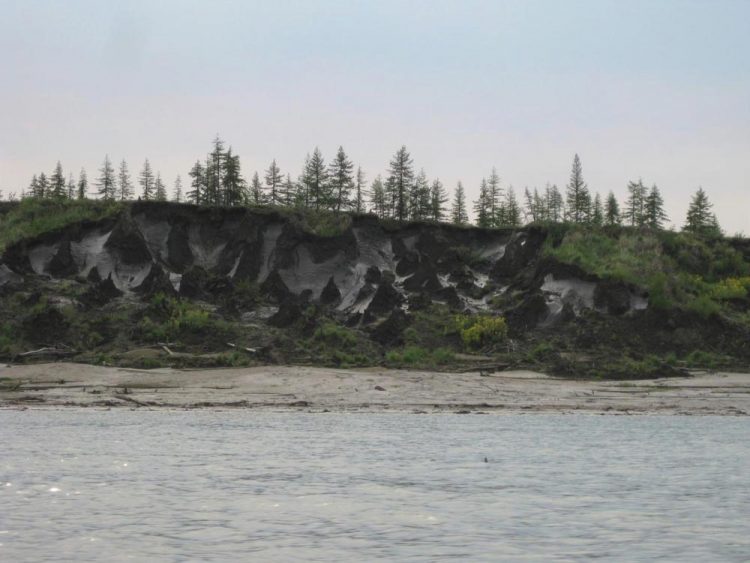Arctic rivers provide fingerprint of carbon release from thawing permafrost

A view over Kolyma river. Credit: Jorien Vonk/Stockholm University
Arctic permafrost and peatlands constitute frozen giants of the global carbon cycle. In the top few meters, the Arctic permafrost stores almost twice as much carbon as atmospheric CO2 and more than 200 times as much as atmospheric methane.
The large amounts of currently dormant permafrost carbon may be increasingly thawed and mobilized as climate warming progresses – and may then feed additional CO2 and methane into the atmosphere to accelerate climate warming.
This climate-carbon feedback is hard to assess as permafrost thaw differs widely across the Arctic and data from remote areas are limited. The new study provides a novel angle by using the radiocarbon signal of large rivers to understand permafrost thaw and carbon mobilization in their catchments.
“Rivers transport carbon from different sources in their catchments, including carbon mobilized from thawing permafrost or collapsing peat, as well as carbon from the soil surface. Radiocarbon dating helps us distinguish carbon from these different sources,” says Birgit Wild, researcher at Stockholm University and lead author of the study.
Old carbon that has been preserved in deep permafrost or peat deposits for thousands of years thus contains less radiocarbon than modern carbon at the soil surface. The team of researchers calculated the flux of permafrost and peat carbon in the large Siberian rivers Ob, Yenisey, Lena and Kolyma by combining a database of radiocarbon in different deposits with monitoring of radiocarbon in the rivers over ten years and all seasons.
The study shows that permafrost and peat carbon contributed to only 12% of the dissolved organic carbon in these rivers, but to more than half of the particulate organic carbon. Seasonal differences suggest that gradual thaw of the seasonally frozen active layer and of surface permafrost is the main source of permafrost- and peat-derived carbon in dissolved form, whereas that in particulate form stems to a large extent from the collapse of deeper deposits that formed thousands of years ago.
Differences in the relative amounts of dissolved versus particulate permafrost and peat carbon between rivers were consistent with differences in the type and extent of permafrost in their basins.
“The radiocarbon signal of especially particulate organic carbon in rivers might be a sensitive tool to monitor carbon release from thawing permafrost over the coming decades,” adds Örjan Gustafsson, professor at Stockholm University and leader of the team.
###
For further information and photos contact:
Dr. Birgit Wild, Department of Environmental Science and Analytical Chemistry and the Bolin Centre for Climate Research, Stockholm University, Email: birgit.wild@aces.su.se; Tel.: +46 76 561 00 02
Prof. Örjan Gustafsson, Department of Environmental Science and Analytical Chemistry and the Bolin Centre for Climate Research, Stockholm University, Email: orjan.gustafsson@aces.su.se; Tel.: +46 70 324 73 17
Media Contact
All latest news from the category: Earth Sciences
Earth Sciences (also referred to as Geosciences), which deals with basic issues surrounding our planet, plays a vital role in the area of energy and raw materials supply.
Earth Sciences comprises subjects such as geology, geography, geological informatics, paleontology, mineralogy, petrography, crystallography, geophysics, geodesy, glaciology, cartography, photogrammetry, meteorology and seismology, early-warning systems, earthquake research and polar research.
Newest articles

Hyperspectral imaging lidar system achieves remote plastic identification
New technology could remotely identify various types of plastics, offering a valuable tool for future monitoring and analysis of oceanic plastic pollution. Researchers have developed a new hyperspectral Raman imaging…

SwRI awarded $26 million to develop NOAA magnetometers
SW-MAG data will help NOAA predict, mitigate the effects of space weather. NASA and the National Oceanic and Atmospheric Administration (NOAA) recently awarded Southwest Research Institute a $26 million contract…

Protein that helps cancer cells dodge CAR T cell therapy
Discovery could lead to new treatments for blood cancer patients currently facing limited options. Scientists at City of Hope®, one of the largest and most advanced cancer research and treatment…



